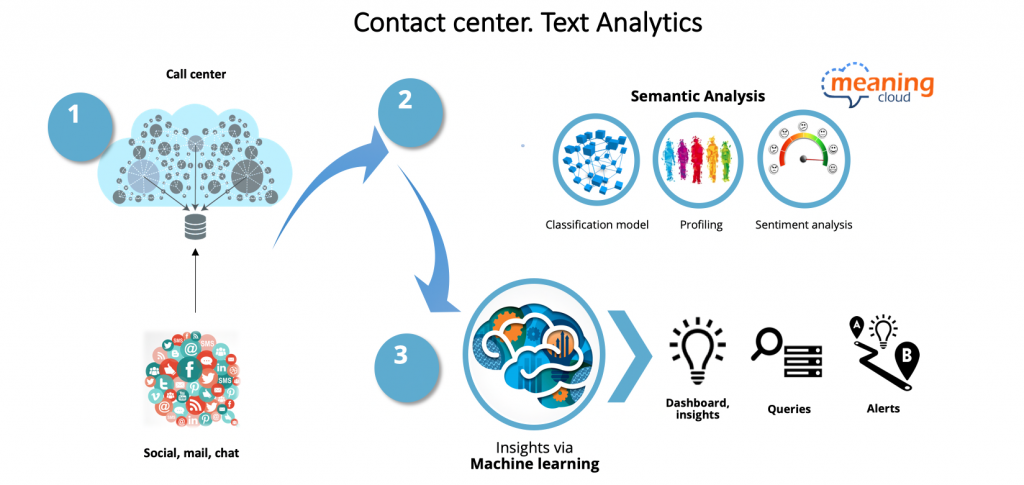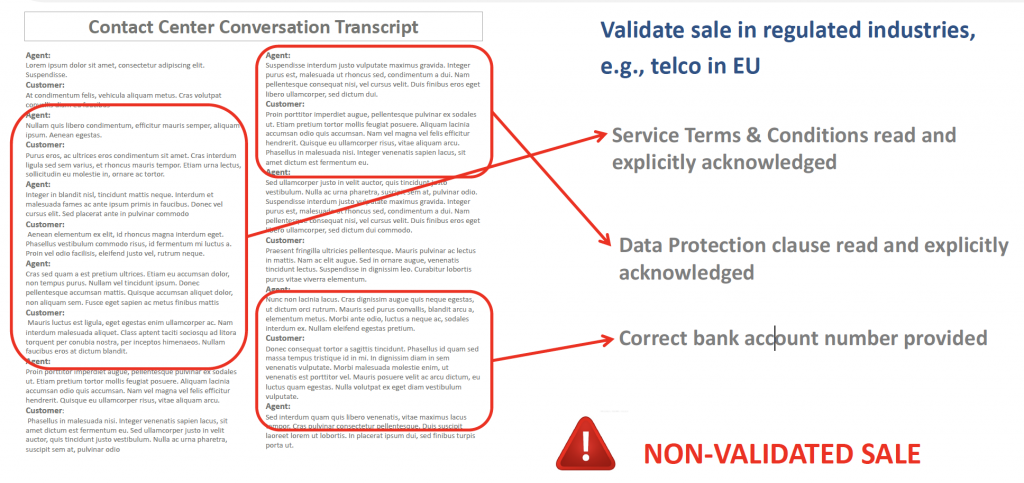
At contact centers, text analytics technology provides an unprecedented opportunity to convert customer interactions into business opportunities. We can improve customer experience, boost sales, reduce customer churn and streamline the efficiency of the processes.
Some years ago, leveraging this opportunity was not possible.
On the one hand, the information available is massive, consisting of thousands of hours of conversations and millions of data points. On the other hand, human language is complicated for machines. There are thousands of different human languages. Words can be ambiguous: Their meaning is dependent on their context. As a result, many companies ignored this data. It turned into an untapped resource stored in many businesses’ archives.
Recent technological advances are removing these obstacles. Natural Language Processing (NLP) technology automatically processes and analyzes text content and supplies valuable information, transforming that “raw” data into structured, manageable information.
Workflow
Communication with our customers occurs beyond telephone-based centers. In addition to call transcripts, new sources of text, such as customer surveys, twitter feeds and other social media posts, web forms, chat sessions with customer service reps and emails are all proliferating.
Regularly, the starting point of the analytics work is a corpus or set of recorded calls. We then transcribe the calls into text.
Each transcript is first parsed to extract the information as a list of utterances. Each utterance contains:
- The identification of a speaker (AGENT or CUSTOMER). If no specific ID appears, we have classifiers to infer this with the text.
- The time the call was initiated.
- The transcription of the call.
Then, each interaction is processed using our semantic technology, initially utterance by utterance, but aggregating the information as the operation progresses.
If they exist, other text-based sources of the contact center, such as web forms, social media or emails, are added to the semantic analysis.
In a new post that we are publishing next week, we are sharing a detailed description of the solution for a customer where Speech Analytics is an essential part of the solution.

6 benefits for contact centers that leverage text analytics
Text and speech analytics genuinely allow for a significant improvement in a contact center’s performance.
Recorded phone conversations and text-based interactions are an underused resource that firms have, to analyze customer experience and, in turn, enhance customer loyalty. With speech and text analytics, it is possible to focus on your top business interests, find out what customers’ topmost concerns are, what’s making them angry, what’s causing them to part, and most importantly, do something about it.
Although, it could be argued that implementing a text analytics system can reinvigorate sluggish operations due to stress on improved execution.
We provide solutions for each of the two different but complementary scenarios in the speech analytics process:
- Real-time analysis of the call, to enable early detection of eventual warnings or provide real-time conversational guidance
- Offline analysis and mining collections of complete calls
1. Customer experience: identify the root causes
Understanding our customers is one of the reasons some organizations implement Text or Speech Analytics in their contact centers.
First, text analytics can detect behavioral signals (emotion, empathy, communication) in real-time and provide live guidance to improve the quality of every interaction.
Text analytics can be used to mine conversations to help understand customers: detect unmet needs and product ideas, indicators of (dis)satisfaction, reputation, etc.
2. Optimize the operation of the contact center: First Call Resolution
Speech and text analysis can mine conversations to optimize the operation of the contact center: Quality audit, response levels, customer satisfaction, and identification of best practices.
First Call Resolution (FCR)
It is important to meet a customer’s needs fully the first time they call, eliminating the need for the customer to follow up with a second call.
Managers carefully monitor follow-up calls because they are an indication of customer dissatisfaction and overall create an increased inflow of calls.
Speech analytics helps reduce costs by providing organizations with the insight to reduce the volume of repeat calls.
Whenever an analysis reveals a problem, operators can take that information into account and help decrease the number of call-backs.
Similarly, routing customers to the right department can be one of the factors aiding customer retention as the possibilities of getting a solution in the first call rise.
3. Reduce the number of at-risk customers
Firms use text and speech analytics to recognize customers that could be on the verge of leaving. Once detected, they can be proactively reached, or their calls can be forwarded to representatives specially instructed to deal with such clients at risk.
4. Compliance: agents’ adherence to scripts and regulations
Speech and text analytics can help improve compliance because it analyses every single interaction an agent has. The degree of compliance that is now obtained as a result was not possible when assurance was solely dependent on traditional random compliance checks.
Especially in highly regulated industries, call center agents must be very observant of the approved script. By utilizing a speech analytics solution, managers can mine calls to guarantee that operators are correctly following the script and performing at their best.
For example, in the EU’s highly regulated telco industry a validated sale must be compliant of some explicit utterances by the customers and the agents during the call. The Service Terms & Conditions should be read and explicitly acknowledged, The Data Protection clause read and explicitly acknowledged and a correct bank account number provided.

5. Sales
Analytics can help recognize the best-practice methods of securing a purchase. This way it is possible to learn from the top-performers. It can also provide representatives with a clear advantage in cross and up-sales by identifying specific product or services they can offer during the call.
6. Identify training needs
Measuring the right responses in the calling process makes it possible to recognize the abilities needed to achieve outstanding outcomes. The insights can help to create first call resolution approaches for training operators with enhanced levels of customer satisfaction.
If you have any questions about our solutions, we are available at support@meaningcloud.com.

